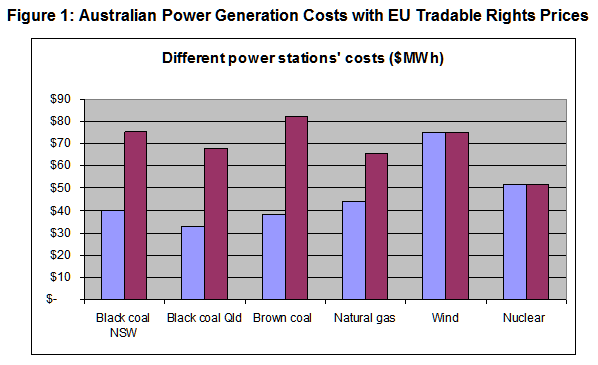Australian electricity generation is 90 per cent coal. Because it is inexpensive and located conveniently to major electricity loads, now that market systems have replaced the centrally controlled direction, Australia’s power costs are among the lowest in the world.
However, electricity costs change markedly in a Kyoto constrained environment. This is true whether the measures in place to reduce carbon dioxide emissions are a form of cap and trade regulation, a carbon tax or even a more arbitrary set of regulations that have similar effects.
Australian measures ostensibly aimed at reducing carbon dioxide emissions appear in many forms and vary from one state to another. They impact most heavily on coal, Australia’s lowest cost energy source and include:
Advertisement
- the Federal Government’s Mandatory Renewable Energy Target (MRET);
- the Queensland Government’s 13 per cent gas target;
- the NSW Government’s Greenhouse Gas Abatement Certificate (NGAC) scheme;
- subsidies to wind and other exotic renewable sources offered through the Australian Greenhouse Office and state governments (the latter in the form of regulatory measures that reduce connection costs to wind generation); and
- schemes that mandate minimum energy savings on appliances. First applied to fridges and freezers and targeted at energy conservation, these regulatory requirements have been re-badged as greenhouse measures and extended to include houses.
The MRET scheme focuses on renewable energy and requires retailers to acquire and annually surrender a progressively increased number of Renewable Energy Certificates (RECs). These essentially require usage of novel energy sources like wind, though some existing and expanded hydro capacity is eligible. By 2010, 9,500 GWh (around 4.5 per cent of demand) will be required under the MRET scheme. For the three schemes combined, over 30,000 GWh is estimated to be covered amounting to over 13 per cent of total demand.
The Queensland scheme seeks to substitute gas for coal-based electricity inputs. The NSW scheme seeks to introduce a penalty on CO2 graduated in line with the emissions per unit of energy of each electricity generation source.
The default penalty costs of the three regulatory measures provide a cap on the costs they are likely to entail. These costs entail a premium over the costs of conventional electricity to retailers. By 2010, when the schemes are fully mature, the fall back penalty rates for the Commonwealth, NSW and Queensland schemes respectively will be $40, $14.3 and $13.1 per MWh. Present rates are below these levels but are expected to equal them once the requirements are fully phased in.
Table 1 below summarises the more readily identified costs.

Advertisement
A greenhouse trading regime has considerable support in Australia, with most state governments urging national adoption. This would entail a cost, which for a similar scheme in operation in the EU works out at $41. Figure 1 below estimates the costs of electricity with and without the sort of additional charges implicit if Australia adopted the EU cap and trade scheme and left other schemes in place. The estimates are based on the carbon dioxide content of the different fuels.
Based on recent developments, we have relatively good information on the costs of conventional generation for the eastern seaboard of Australia. For coal, these vary from about $32 per MWh in Queensland, around $40 in NSW and $38 in Victoria. Gas is estimated at around $45 per MWh based on a cost of $4 per Gj, a cost that may rise if greenhouse measures raise the demand for gas.
Nuclear costs have been taken from a recent University of Chicago report (the costs exclude disposal and de-commissioning costs which would add 10-15 per cent). Doubtless given the strength of the anti-nuclear lobby in Australia and its capacity to cause additional costs and delays, the estimates provided would be conservative
Wind power at $75 per MWh represents the costs at prime sites. These costs exclude any additional transmission charges that may be required for the more remotely located facilities. They also do not take into account the need for conventional power back up which is necessary once wind, with its unpredictable and intermittent nature, becomes a significant component of the aggregate supply.
Applying the EU price of $41 per tonne of CO2, cost to current power sources would result in nuclear power becoming marginally cheaper than coal and natural gas generation.

Use of alternative fuels to the coal (with some gas and hydro) that presently feeds Australia’s power industry would entail sharp cost increases. Wind is so costly that it is not a viable long term energy solution. In the case of nuclear, even if it were able to meet its estimated costs, it would entail an increase in generation costs by at least a quarter. Natural gas, if used extensively for base load (as opposed to its present role in supplying peak power) would be still more expensive.
Discuss in our Forums
See what other readers are saying about this article!
Click here to read & post comments.
16 posts so far.